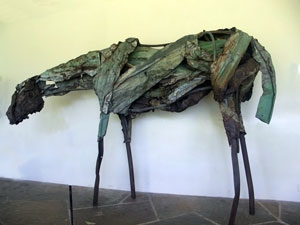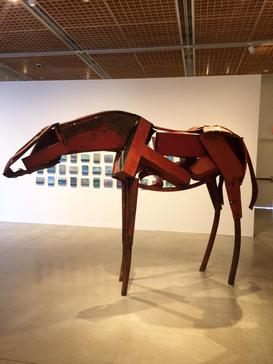Deborah Butterfield facts for kids
Quick facts for kids
Deborah Butterfield
|
|
|---|---|

Sculpture by Deborah Butterfield, 1986,
Honolulu Museum of Art Spalding House |
|
| Born | May 7, 1949 |
| Nationality | American |
| Education | University of California, Davis |
| Known for | Sculpture |
Deborah Kay Butterfield (born May 7, 1949) is an American artist who creates amazing sculptures. She is famous for making sculptures of horses. What makes her art special is that she uses unusual materials like metal and pieces of wood.
Deborah splits her time between a farm in Bozeman, Montana, and a studio in Hawaii. She lives with her husband, who is also an artist, John Buck.
Contents
About Deborah's Art Journey
Deborah Butterfield was born on May 7, 1949. This was the same day as the 75th Kentucky Derby, a famous horse race! She says this might have inspired her love for horses.
At first, Deborah wanted to sculpt human figures. But her teacher, Manuel Neri, was already very well known for that. So, she decided to create sculptures of horses instead. She used the horses to represent herself and her feelings. Over time, horses became her main focus.
Deborah studied art at the University of California, Davis. She earned her bachelor's degree in 1972 and her master's degree in 1973. This is where she met her husband, John Buck. They got married in 1974.
She also taught sculpture at the University of Wisconsin–Madison and Montana State University – Bozeman. She taught from the mid-1970s to the mid-1980s. Since 1986, she has spent her summers in Montana and her winters in Hawaii.
Her Career and Artworks

Deborah Butterfield's art is very popular. Many art collectors want her sculptures. Her first artworks in the mid-1970s were made from sticks and natural bits she found on her farm in Montana. She wanted these materials to show that the horses were part of nature.
In the early 1980s, she started making horses from scrap metal and bronze. She would first build a sculpture using wood and wire. Then, she would take photos of it from all sides. This helped her put the piece together again using metal.
Horses as a Symbol
Deborah Butterfield has explained that her horse sculptures are like self-portraits. She said, "I first used the horse images as a metaphorical substitute for myself." It was a way to show herself without directly making a sculpture of a person.
She also made a statement about women through her art. She said, "I wanted to do these big, beautiful mares that were as strong and imposing as stallions but capable of creation and nourishing life." She wanted to show that female horses (mares) are powerful and can create life, just like male horses (stallions) are seen as strong.
Art critic Grace Glueck wrote in The New York Times that Deborah's horses feel fresh and unique. She said that Deborah sees each horse as an individual. Deborah trains and rides horses on her farm. She feels that her sculptures show the true spirit of horses.
Where to See Her Art
Deborah Butterfield's art is shown in many places. You can find her sculptures in galleries like Marlborough Gallery in New York and Anglim Gilbert Gallery in San Francisco.
Her work is also in many public museums. These include the Honolulu Museum of Art, the Whitney Museum of American Art in New York City, and the Metropolitan Museum of Art. The Delaware Art Museum and the Boise Art Museum also have her sculptures.
In the Pappajohn Sculpture Park in Des Moines, Iowa, you can see two of her sculptures: Juno (1989) and Ancient Forest (2009).
How She Builds Her Sculptures
Deborah Butterfield started by using natural materials like mud, clay, and sticks in the 1970s. Later, she began using metal. In 1979, she started using recycled materials like old steel and scrap metal.
For the last 20 years, she has used bronze casts of "stray, downed pieces of wood." This means she carefully picks pieces of wood that look like the shape of a horse. Then, these wood pieces are used to make a mold, and hot bronze is poured into it. The wood burns away, leaving a bronze sculpture that looks exactly like the wood pieces.
Deborah says she gets ideas from the "pile of junk" she sees. She looks for interesting shapes and lines in the discarded objects. Using "junk" helps her find unique forms for her horse sculptures.
See also
- Horses in art

